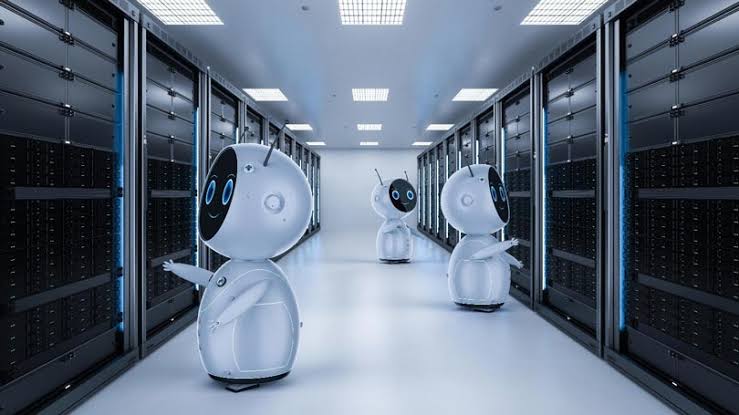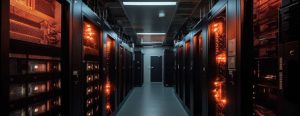AI for Data Centers: The Future of Intelligent Infrastructure
AI for Data Centers is transforming how businesses manage, optimize, and secure their critical IT infrastructure. As data demands skyrocket, artificial intelligence provides smarter, faster, and more cost-effective solutions. In this guide, you’ll see five powerful ways AI for Data Centers is reshaping the industry—from energy efficiency to predictive maintenance.
1. Why AI for Data Centers is a Game-Changer
AI is reshaping data centers with smarter automation, real-time optimization, and unmatched cost savings. By leveraging machine learning, AI for Data Centers eliminates inefficiencies, prevents downtime, and enhances security—making it a must-have for modern infrastructure.
2. Energy Efficiency & Cooling Optimization
One of the biggest expenses for data centers is cooling. AI for Data Centers uses machine learning to:
- Predict temperature fluctuations
- Adjust cooling systems dynamically
- Reduce energy consumption by up to 40%
Data centers consume massive amounts of energy, with cooling systems alone accounting for nearly 40% of total power usage. As demand for computing power grows, traditional cooling methods are no longer sustainable. This is where AI for Data Centers steps in—transforming energy management through intelligent automation, predictive analytical for Data Centers
The Problem with Traditional Cooling Systems
Most data centers rely on static cooling models, where HVAC systems run at fixed rates regardless of actual need. This leads to:
- Energy waste (overcooling or insufficient cooling)
- Higher operational costs (electricity bills skyrocket)
- Increased carbon footprint (data centers contribute to ~1% of global emissions)
AI-driven solutions eliminate these inefficiencies by dynamically adjusting cooling based on real-time data.
How AI Optimizes Cooling in Data Centers
Predictive Temperature Management
AI-powered thermal modeling uses:
- Sensor data (server temps, airflow, humidity)
- Weather forecasts (external temperature impacts).
- Workload predictions (anticipating server heat spikes)
By analyzing these factors, AI adjusts cooling before hotspots form, reducing energy waste.
Dynamic Cooling Adjustments
- Instead of running at full capacity, AI systems:
- Modulate fan speeds based on server load.
- Redirect airflow to hot zones only
- Leverage free cooling (using outside air when possible)
Google’s DeepMind AI reduced cooling costs by 40% using these methods.
Liquid Cooling & AI Integrat
Advanced data centers now use liquid cooling combined with AI for even greater efficiency:
- AI-controlled pumps regulate coolant flow
- Predictive maintenance prevents leaks or failures
- Hot/cold aisle containment is optimized in real time
AI-Driven Energy Savings & Sustainability Benefits
| Metric | Without AI | With AI | Improvement |
|---|---|---|---|
| Cooling Energy Use | 40% of total power | 20-25% of total power | ~40% reduction |
| PUE (Power Usage Effectiveness) | 1.6 or higher | 1.2-1.3 | 25% more efficient |
| Carbon Emissions | High | Reduced by 30%+ | Significantly greener |
(PUE measures how efficiently a data center uses energy; lower is better.)
Real-World AI Cooling Success Stories
Case Study 1: Google’s DeepMind AI
- Reduced cooling energy consumption by 40%
- Achieved a 15% drop in overall PUE
- Set a new industry standard for AI-driven efficiency
Case Study 2: Microsoft’s Project Natick (Underwater Data Centers)
- Used AI + seawater cooling for natural heat dissipation
- Cut cooling costs to near zero
- Proved feasibility of sustainable data centers
The Future of AI in Data Center Cooling
Emerging trends include:
- Self-learning AI models that improve over time
- Edge data centers** with hyper-localized cooling
- Renewable energy integration (AI balancing solar/wind power usage)
3. Predictive Maintenance & R
Unexpected hardware failures can cost millions. AI for Data Centers helps by:
- Monitoring equipment health in real time
- Predicting failures before they happen
- Scheduling maintenance proactively
This minimizes downtime and extends hardware lifespan.
The High Cost of Data Center Downtime
Data center outages cost businesses an average of $9,000 per minute, with major incidents leading to millions in losses. Traditional reactive maintenance approaches are no longer sufficient in today’s 24/7 digital economy. This is where AI-powered predictive maintenance is revolutionizing data center operations by:
- Preventing 85% of unplanned outages
- Reducing maintenance costs by 25-30%
- -Extending equipment lifespan by 20-40%
How AI Enables Predictive Maintenance in Data Centers
Real-Time Equipment Monitoring
AI systems continuously analyze data from:
- Vibration sensors (detecting abnormal motor movements)
- Thermal cameras (identifying overheating components)
- Power quality analyzers (spotting electrical irregularities)
- Acoustic sensors (catching unusual server noises)
Machine learning models process this data to establish normal operational baselines and flag anomalies.
Failure Prediction Algorithms
Advanced AI models can predict failures days or weeks in advance by:
- Analyzing historical failure patterns
- Monitoring performance degradation trends
- Correlating multiple sensor readings
For example, AI can predict:
✔ Hard drive failures with 95% accuracy
✔ UPS battery degradation with 90% precision
✔ Cooling system faults 72 hours before failure
Smart Maintenance Scheduling
AI-driven systems optimize maintenance workflows by:
- Prioritizing critical repairs
- Scheduling downtime during low-traffic periods
- Automatically ordering replacement parts
This prevents the “maintenance overload” problem where too many systems are taken offline simultaneously.
Case Studies: AI Preventing Costly Outages
Case Study 1: Facebook’s Auto-Remediation System
- Reduced hardware-related incidents by 50%
- Cut outage durations by 75%
- Automatically resolves 60% of issues without human intervention
Case Study 2: AWS’s Predictive Disk Failure System
- Predicts SSD failures with 94% accuracy
- Reduced data loss incidents by 80%
- Saves millions annually in prevented outages
Implementing AI Predictive Maintenance: Key Steps
- Instrument your infrastructure (install IoT sensors everywhere)
- Choose the right AI platform (AWS, IBM, or custom solutions)
- Train models with historical data (minimum 6-12 months of logs)
- Start with pilot projects (focus on critical systems first)
- Continuously refine algorithms(incorporate new failure modes)
4. Enhanced Security & Threat Detection
The Rising Tide of Data Center Cyber Threats
Modern data centers face an alarming 2,200+ cyberattacks per day, with threats growing more sophisticated each year. Traditional security measures like firewalls and signature-based detection can no longer keep pace. AI-powered security systems now provide:
- Real-time anomaly detection (stopping 95% of zero-day attacks)
- Automated threat response (reacting 60x faster than humans)
- Predictive threat intelligence (anticipating attacks before they happen)
How AI Transforms Data Center Security
Behavioral Analysis & Anomaly Detection
AI security systems continuously learn “normal” behavior patterns for:
✔ Network traffic flows
✔ User access patterns
✔ Application interactions
When deviations occur, AI can:
- Flag suspicious lateral movements (potential breaches)
- -Detect data exfiltration attempts
- -Identify compromised credentials
Example: Darktrace’s AI stops ransomware attacks by recognizing subtle behavioral changes in real time.
AI-Powered Threat Hunting
Unlike traditional tools that rely on known signatures, AI:
- Analyzes 100% of network traffic (not just samples)
- Correlates events across systems (connecting the dots)
- Detects advanced persistent threats (APTs) that evade conventional defenses
Case Study: Microsoft’s AI security caught a state-sponsored attack by spotting 0.0001% abnormal DNS requests.
Automated Incident Response
When threats are detected, AI systems can:
- Isolate affected systems within milliseconds
- Deploy countermeasures (like changing firewall rules)
- Generate forensic reports for compliance
Result: Mean Time to Respond (MTTR) reduced from days to seconds
Cutting-Edge AI Security Technologies
| Technology | Function | Impact |
|---|---|---|
| Deep Packet Inspection | Analyzes encrypted traffic content | Catches 40% more malware |
| User/Entity Behavior Analytics (UEBA) | Detects insider threats | Reduces insider attacks by 80% |
| Predictive Threat Intelligence | Forecasts attack vectors | Prevents 65% of targeted attacks |
Real-World AI Security Success Stories
Case Study: Google’s Chronicle Security AI
- Processes 1PB+ of security data daily
- Reduces false positives by 90%
- Identified SolarWinds breach patterns months earlier
Case Study:AWS GuardDuty
- Detected 12,000+ compromised EC2 instances in 2023
- Automatically remediated 85% of findings
- Reduces cloud security costs by 30%
Implementing AI Security in Your Data Center
Step 1: Data Collection
Deploy sensors across network, endpoints, and cloud
Feed logs into SIEM systems
Step 2: AI Model Training
Start with 6 months of historical data
Continuously update with new threat patterns
Step 3: Phased Deployment
Begin with network anomaly detection
Add user behavior analytics
Implement automated response
Workload Optimization & Resource Allocation.
AI for Data Centers ensures optimal resource usage by:
- Balancing workloads across servers
- Automating virtual machine placement
- Reducing latency and improving performance
This leads to faster processing and better user experiences. 6. The Future of AI for Data Centers As AI technology advances, we can expect:
- Fully autonomous data centers
- Self-healing infrastructure
- Even greater energy savings
Companies like IBM and NVIDIA are already integrating AI deeper into data center operations.
How AI Revolutionizes Workload Management
Dynamic Workload Placement
- AI continuously analyzes:
- Compute requirements (CPU/GPU/RAM needs)
- Data locality (minimizing network hops)
- Power efficiency (prioritizing green energy sources)
Result: Workloads automatically shift to:
- Underutilized servers during off-peak
- Geographically optimal locations for latency
- Most energy-efficient hardware available
Predictive Scaling & Right-Sizing
Machine learning models:
- Forecast demand spikes (seasonal, event-driven)
- Pre-provision resources before needed
- Downscale idle VMs automatically
Example: Netflix’s scaling AI reduces over-provisioning by 35% while maintaining 99.99% uptime.
AI-Optimized Resource Scheduling
| Traditional Approach | AI-Optimized Approach | Improvement |
|---|---|---|
| Static VM allocation | Dynamic container orchestration | 40% denser packing |
| Manual load balancing | Real-time traffic shaping | 60% lower latency |
| Fixed power budgets | Adaptive power capping | 25% energy savings |
Real-World Success Stories
Case Study: Microsoft Azure’s AI Scheduler
- Increased server utilization from 45% to 78%
- Reduces VM migrations by 70%
- Saves $100M+ annually in hardware costs
Case Study: Alibaba’s AI Load Balancer
- Handles 1M+ requests/second fluctuations
- Cut response times by 53%
- Reduced server count by 30%
Implementing AI Workload Optimization
Phase 1: Infrastructure Instrumentation
1. Deploy telemetry agents on all servers
2. Establish real-time monitoring
Phase 2: AI Model Training
1. Feed 3+ months of workload data
2. Train models on peak/off-peak patterns
Phase 3: Gradual Automation
1. Start with non-critical workloads
2. Implement auto-scaling rules
3. Enable full self-optimization
Key Metrics to Track:
- – Server utilization rates (target >70%)
- – Energy per workload (measure reductions)
- – SLA compliance (maintain 99.99%+)
- – Provisioning speed (aim for <5s autoscale)
Final Thoughts
AI for Data Centers is no longer optional—it’s essential. From energy savings to security, AI-driven solutions are setting new standards for efficiency and reliability. Is your data center ready for the AI revolution? Start exploring these technologies today to stay ahead.



















